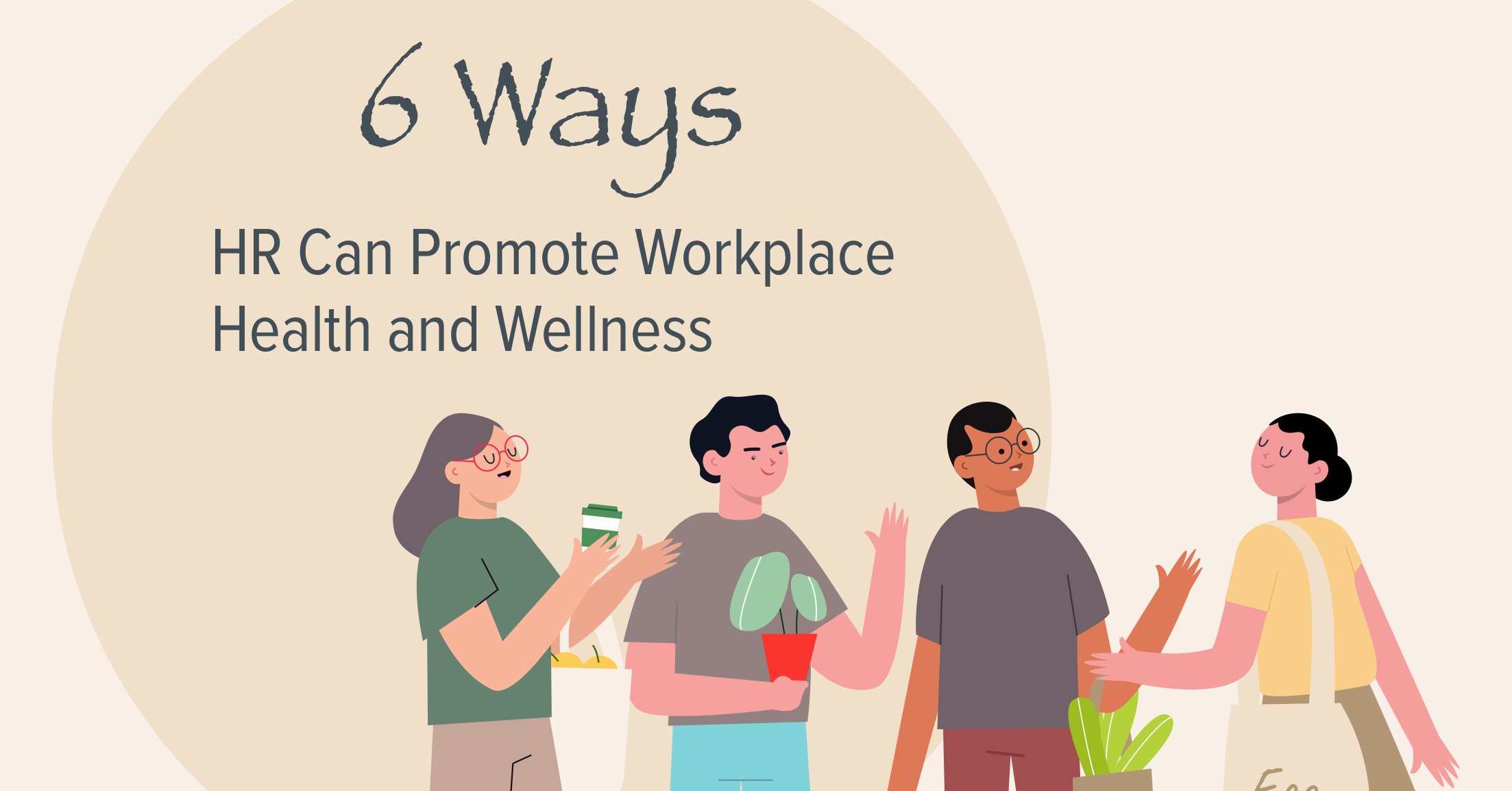6 Ways HR Can Promote Workplace Health and Wellness



 Cut onboarding time
by 60%—here's the
Ultimate Checklist
that helped do it.
Cut onboarding time
by 60%—here's the
Ultimate Checklist
that helped do it.

Workplace health and wellness is critical to a healthy, happy workforce. Sick or unhappy employees aren’t operating at 100%, which means neither is your workplace. Building a culture of workplace health and wellness can take a bit of work to implement and get employees on board, but it’s worth the effort.
If you are an HR professional who is looking to build a culture of wellness, promote health, and improve the health of your workplace, here are six tactics you can use.
1. Create a flexible working environment
We’ve all heard about the term “work-life balance” but in reality, achieving that balance isn’t feasible. It’s more of a sliding scale, which is why we should strive for flexibility over “balance.” If your employees are chronically stressed, this can lead to many deadly illnesses. By working to eliminate or at the very least mitigate their stress at work, you can help boost morale and show them how much you care about their wellness.
So how do you achieve that? Consider the following:
-
Meditation rooms
-
Flexible schedules
-
Outdoor workspaces
-
Remote work options
-
Encourage employees to use their PTO (and mean it)
-
Mindfulness training
-
Unlimited PTO
All of the above help reduce stress, promote health, and work to achieve flexibility for your employees. If they have the option to work remotely or create their own schedules, then they don’t have to feel stressed about getting their car serviced, taking their kids to the doctor, or running errands that need to be completed during standard business hours.
Related Reading: The Remote Workforce is the New Normal
But this starts at the top. Employees need to see their bosses taking time off, working remotely, disconnecting, etc. It needs to be a part of the culture for people to feel comfortable actually taking advantage of some of these flexible options.

2. Ensure employee healthcare is a top priority
Employee health and wellness is an attempt to take a proactive approach versus a reactive one. The first line of defense when it comes to your employees’ health and wellness are the benefits that you provide to them.
Employees need to be able to afford their health care. How often do we hear about people not going to the doctor because they can’t afford it? By providing employees with affordable, low-cost insurance plans or even an onsite clinic, they can take advantage of preventative care. This allows them the ability to stop avoiding putting things off until they get so bad they become much bigger issues down the road.

3. Establish or reinforce an employee health and wellness program
If you’re looking to increase productivity, reduce sick days, and improve employee well-being, small lifestyle changes can make a big difference. Encouraging healthy habits like regular movement, balanced nutrition, and juicing for health can contribute to a more energized and engaged workforce. We encourage putting an employee health and wellness plan in place. If you have one in place already, be sure you encourage employees to take advantage of it and actually participating. If you don’t have one and you’re looking to get serious about improving workplace health, now is the time to draft a plan.
Related Reading: What HR Leaders Must Include in Employee Wellness Programs

4. Get employees moving throughout the day
According to the Mayo Clinic, sitting for long periods of time is linked to a number of health issues: increased blood pressure, high blood sugar, excess body fat around the waist and abnormal cholesterol levels, obesity, and more. Prolonged sitting can also increase the risk of death from cardiovascular disease and cancer.
Many jobs today require working on a computer leading to prolonged sedentariness. Encourage employees to get up and get move throughout the da. It can help break up the amount of time they’re seated.
Here are a few ways to encourage your employees to be physically active throughout the day:
-
Give extra breaks for people to get up, move around and stretch
-
Provide employees standing desks or under-desk ellipticals or cycles
-
Bring in a fitness instructor a few times a week. Things like yoga, Zumba, martial arts, or barre are all great examples of active exercises that don’t require much, if any, equipment.
Again, this is one of those things that management and HR need to practice what they’re preaching. If your employees see you taking advantage of the extra breaks to get up and move around, they’re more likely to follow suit.

5. Stress the importance of your safety policies
If you have safety policies in place, that’s great. If you don’t, you should. But your policies are only as helpful to the degree that your employees know about and practice them.
Job incident prevention is a key piece to working towards a positive workplace environment. Every seven seconds a worker is injured on the job, according to the National Safety Council. That equates to over 12,600 injuries every day!
How can you work to prevent your company from becoming part of that statistic? By providing ongoing safety training and additional training for management. Empower your management team with the tools they need to reinforce the policies and takeaways moving forward. Display visible reminders around your workplace on the safety guidelines. Especially in hazardous areas where accidents might be more prone to occur.

6. Encourage communication
All of these ideas are great to try and promote health and wellness, but if they aren’t working for your employees, they need to feel empowered to speak up. By the time most employers notice an employee is burnt out, physically, mentally or both, it’s often too late. Establishing an open line of communication can help you know about these issues well before they become an actual problem.
You can implement an open-door policy and make sure you have regular check-ins and connection with everyone on your staff. Encourage employees to express concerns. This can help foster healthy relationships so employees will feel comfortable telling you when they’re beginning to feel burnt out.

Key Takeaways:
There are many ways to promote health and have a happier workplace. We recommend starting with these six:
-
Create a flexible working environment by allowing work from home and adjustable schedules
-
Make employee health a priority
-
Establish an employee health and wellness program
-
Encourage employees to get up and move and exercise during the workday
-
Stress the importance of your safety policies to try and prevent workplace injuries
-
Establish open channels of communication to avoid employee burnout
About Author: Joe McErlane is the founder and CEO of NeoPath Health, where he has worked to improve employee health for companies looking to control the spiraling cost of employee medical plans. NeoPath establishes and manages onsite clinics that improve care, reduce costs and attract and retain employees.
 Discover how our HR solutions streamline onboarding, boost employee engagement, and simplify HR management
Discover how our HR solutions streamline onboarding, boost employee engagement, and simplify HR management
Keep Reading
45 Boss Day Messages That Actually Mean Something (2026 Guide)
When is Boss Day 2026? Mark your calendar for October 16, 2026 — the annual opportunity
Birthday Wishes for Coworkers: 50+ Messages That Build Workplace Connection
A coworker's birthday isn't just another calendar date—it's a meaningful opportunity to
Embracing Diversity: Recognizing Different Cultures in the Workplace
Workplaces today reflect the incredible diversity of the world around us. People bring
Like What You Hear?
We'd love to chat with you more about how HR Cloud® can support your business's HR needs. Book Your Free Demo

Build a Culture of Recognition. Boost Engagement. Guaranteed.
Workmates empowers employees to stay informed, connected, and appreciated—whether they’re on the front line, in the office, or remote. Recognition drives 12x higher engagement.Trusted by industry leaders in every sector




Cut Onboarding Costs by 60%.
Take the confusion and follow-ups out of onboarding with automated workflows, digital forms, and structured portals—so new hires ramp faster 3X quicker.Trusted by industry leaders in every sector




